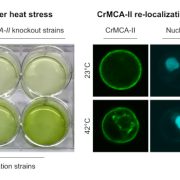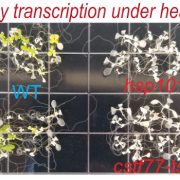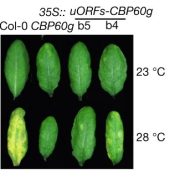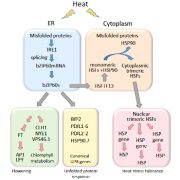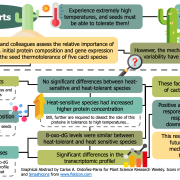Stressing the translatome: It is about time
Titouan Bonnot1 and Dawn H. Nagel1
1Department of Botany and Plant Sciences, University of California, Riverside, Riverside, California, USA
Background: The plant circadian clock synchronizes environmental changes with internal biological processes, by coordinating the timing of expression for genes involved in important regulatory pathways. Understanding how plants modulate their molecular responses to unpredictable and growth-limiting temperatures (>37ºC) depending on the time of day is a key research goal. The clock dynamically regulates mRNA abundance, and most of our knowledge about clock control of gene expression in response to temperature stress has centered around changes at the transcriptome level. However, little is known about how the clock influences other levels of gene regulation, specifically translation. Actively translating mRNA dynamics may better inform protein rhythms involved in stress responses and provide insights on clock regulation.
Question: We wanted to know to what extent heat stress impacts the circadian-regulated translatome in a time-of-day-dependent context.
Findings: Using Translating Ribosome Affinity Purification (TRAP), we isolated translating polyadenylated mRNAs and subjected them to deep sequencing in Arabidopsis. TRAP and Total mRNAs were collected every 3 h over a 24 h circadian period, along with samples collected following 1 h heat stress (~37ºC) applied every 3 h, and 1 h, 3 h, and 6 h post-stress. Time of day significantly altered the translatome in response to heat stress. Most of the circadian translatome recovered within 1 h after removal of the stress. We uncovered putative nodes in the heat stress response network which included transcription factors (TFs) involved in growth regulation. We compared multiple levels of regulation, and highlight shared features between plant and animal clocks. We found several similarities, such as circadian control of the cell cycle and translation initiation, suggesting that beyond the known features shared between eukaryotic clocks, other aspects of gene regulation may also be conserved.
Next steps: As TFs act as key hubs or gatekeepers in important pathways, the nodes identified are candidate TFs that can be manipulated to confer tolerance depending on the time of day the stress is applied. Using CRISPR technology to tweak interactions in the network at different times of the day may contribute to efforts aimed at generating dynamically stress resilient plants.
Titouan Bonnot and Dawn H. Nagel. (2021). Time of day prioritizes the pool of translating mRNAs in response to heat stress. Plant Cell. https://doi.org/10.1093/plcell/koab113



